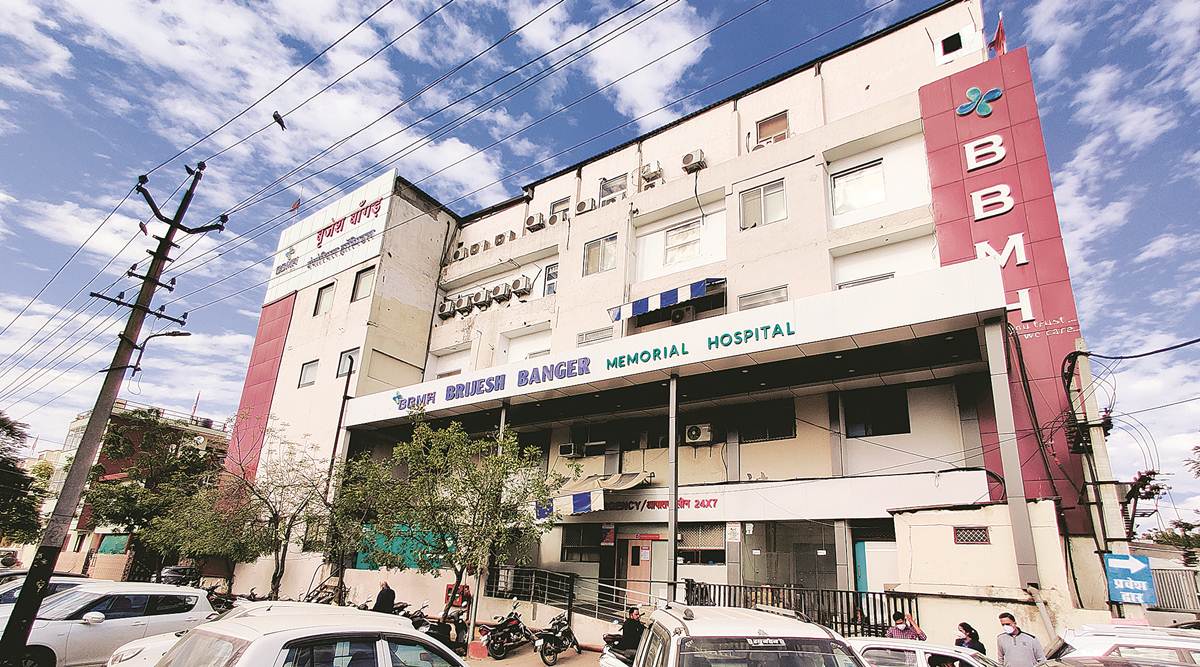 BBM Hospital made national headlines in March, when 16 doctors here tested positive. Now, it is back on its feet. (Express photo by Hamza Khan)
BBM Hospital made national headlines in March, when 16 doctors here tested positive. Now, it is back on its feet. (Express photo by Hamza Khan) “What the people said seemed appropriate to them at the time. It’s all in the past now,” says Dr Alok Mittal, leaning back in his chair inside a small examination room at Brijesh Bangar Memorial Hospital (BBM) in Rajasthan’s Bhilwara.
A senior consultant physician and the medical superintendent at BBM Hospital, Mittal made national headlines in the early days of the pandemic in March when he, along with 16 other doctors and hospital staff tested positive for Covid-19. When local health authorities discovered that Mittal had examined several patients in that period, he received criticism from all sections, with one international publication asking if the outbreak at BBM hospital will turn Bhilwara into “India’s Italy”. Rajasthan Health Minister Raghu Sharma had said he would have the hospital investigated for lapses.
But it didn’t take long for the headlines to change, as the Bhilwara model of “ruthless containment” became a template for other parts of the country for stopping the spread of Covid-19. And nine months later, on a sunny December afternoon, the commotion outside Mittal’s office and at the hospital reflects that change.
“At the time, no one knew what to expect. Sometimes, doctors get infected with meningitis, HIV while treating patients. We were made victims,” says Mittal, dressed in green scrubs, a mask with two bulging filters stretched across his face, and a blue bouffant cap covering his head. “They said things about my son…that he travelled and contracted the virus; all lies. I handed over his passport to the authorities to see for themselves,” he adds.
All 17 doctors and staff recovered from the infection. The 150-bed hospital that has about 25 ICU beds examines 250 patients daily. The number stood at 300 before the pandemic.
Chief Medical and Health Officer (CMHO) Mustak Khan credits swift action by the district administration for stopping the virus. “A strict curfew was imposed and 300 teams were constituted to trace over 6,000 IPD and OPD patients, apart from the entire staff and those in ICU at BBM hospital,” he says.
Over the next few weeks, as many as 11.10 lakh people in 2.22 lakh homes were covered in three surveys in the city alone. In rural limits, 22.39 lakh persons were covered in two surveys. Apart from that, 55.90 lakh persons across the district were covered in routine surveys. While the 2011 Census puts Bhilwara district’s population at a little over 24 lakh, multiple surveys meant that same houses and persons were covered several times over, thus leading to a screening figure of about 90 lakh persons across the district.
Additional District Magistrate Rakesh Kumar says while “there was a lot of uncertainty” at the time, three things helped. “The free hand given to the district collector by the state government, who in turn made an emotional appeal to all of us, jissey alag bhaavna ka janm hua (which created a new energy). Second, the daily meetings with all the key persons and stakeholders helped filter the best ideas and finally, all the best officials and personnel from all departments were attached with the district headquarters, and pressed into service as corona warriors,” he says.
The district now has over 300 active cases, most of them in home isolation, while 9,008 others have been discharged.
About 3 km away from BBM Hospital, at the Bhilwara railway station, Chaudhary (he says he doesn’t have a first name) and his wife Pyari are one of two families waiting at the platform. “We have come from Pali (173 km away). We are waiting for a train to Hyderabad,” says Chaudhary, who runs a business there. Since the train services resumed, 14 trains have been stopping at the station. Surendra Mishra, who runs an Amul outlet near the platform, complains that “business is not even 10 per cent of what it used to be”.
A little distance away, at the bus station, the service is better. “We are currently running a total of 87 buses, covering 33,000 kilometres. We’re trying to increase the service to 102 buses by January, covering 38,000 km on 98 routes,” says Rakesh Saraswat, Chief Manager of Bhilwara bus station, adding that while the revenue dropped to zero during the lockdown, it now stands at Rs 11 lakh per day, down from Rs 12-14 lakh before the pandemic.
Outside the station, Madan Lal, 36, an autorickshaw driver, says while the business is picking up very slowly, “when I returned to work after the lockdown, it felt as if I’ve been freed from a jail”. “From Rs 800-900 earlier, I now make Rs 200-250 daily. It is better than the lockdown when I had no income,” he says.
As the city slowly gets back on its feet, ADM Kumar says the focus now is on creating awareness. “Our approach now is a bit like the warning at railway stations, ‘Yaatri apne samaan ki raksha swayam karein. (Passengers should take care of their own luggage)’,” he says.